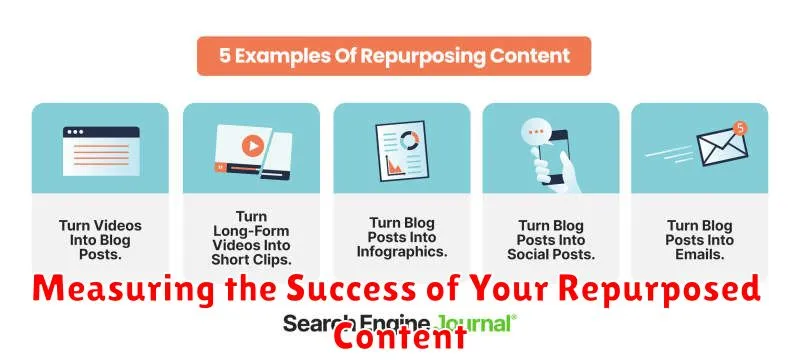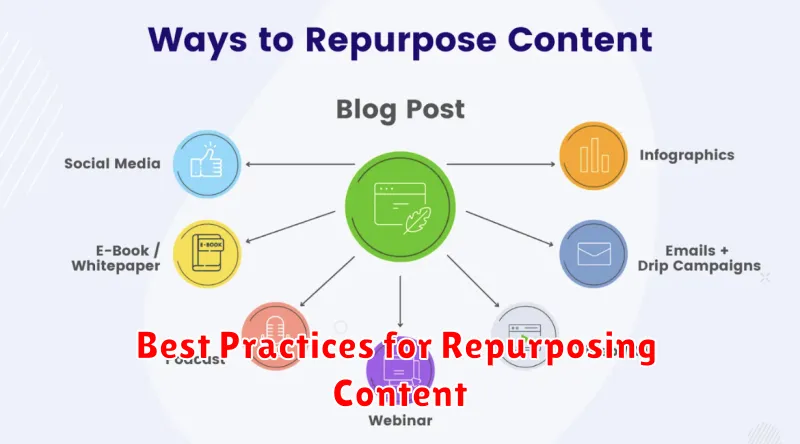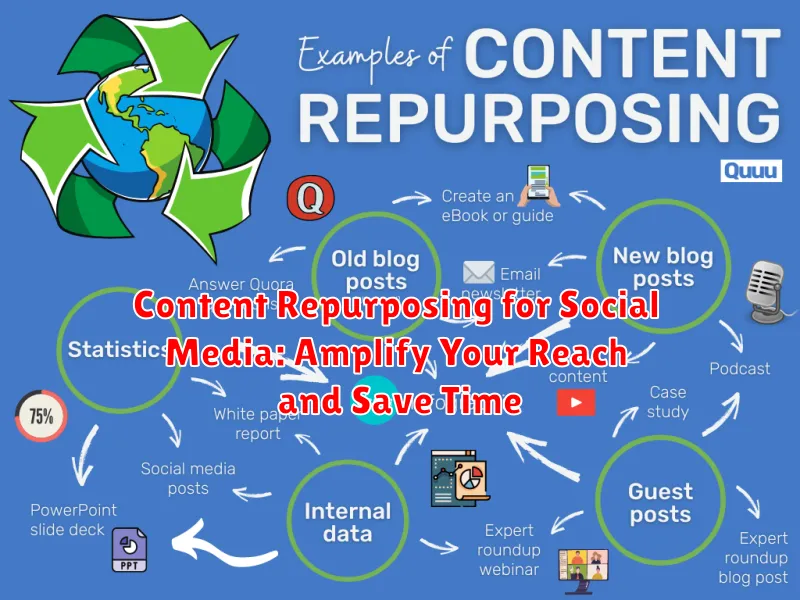In today’s fast-paced digital landscape, content repurposing is no longer a luxury but a necessity for social media success. It’s a powerful strategy that allows you to maximize the reach of your valuable content across various social media platforms while simultaneously saving valuable time and resources. This involves strategically adapting and reformatting existing content into new formats to engage different audiences and extend the lifespan of your original work. Whether you’re working with blog posts, videos, podcasts, or infographics, content repurposing for social media empowers you to connect with a wider audience, reinforce your message, and ultimately achieve your marketing goals more efficiently.
This comprehensive guide will delve into the benefits and best practices of content repurposing for social media. Learn how to transform a single piece of content into multiple engaging formats optimized for various platforms. Discover practical techniques for amplifying your reach and maximizing your impact without starting from scratch every time. From blog posts to Instagram stories, LinkedIn articles to Twitter threads, we’ll explore the effective strategies to save time and effort while boosting your social media presence through content repurposing.
Understanding Content Repurposing
Content repurposing is the practice of transforming existing content into new formats and distributing it across different platforms. It’s not simply copying and pasting; it’s about strategically adapting your message to resonate with various audiences and maximize its lifespan. This process involves taking valuable content, such as blog posts, webinars, or podcasts, and reimagining them as social media updates, infographics, short videos, or other engaging formats.
The core goal of content repurposing is to reach a wider audience and reinforce your message without constantly creating new material from scratch. It’s a highly effective strategy for increasing brand visibility, driving engagement, and saving valuable time and resources.
Benefits of Repurposing Content
Repurposing content offers numerous advantages for social media marketers. It allows you to maximize the value of your existing content by extending its lifespan and reaching a wider audience. This translates to increased brand visibility and engagement across multiple platforms without the need to constantly create new material from scratch.
A key benefit is saving time and resources. Content creation can be time-consuming and expensive. Repurposing allows you to efficiently leverage existing assets, freeing up time for other essential marketing tasks, such as strategy development and community engagement.
Furthermore, repurposing content enables you to reinforce your message. By presenting your core message in various formats across different platforms, you increase the likelihood of it resonating with your target audience and improving brand recall.
Finally, repurposing can improve your SEO. When your content is shared and engaged with across multiple platforms, it signals authority and relevance to search engines, potentially boosting your organic search rankings.
Identifying Repurposable Content
Not all content is created equal when it comes to repurposing. High-performing content is your prime candidate. Look for content that has historically generated significant engagement, such as high website traffic, social media shares, and comments. This indicates audience interest and increases the likelihood of success when repurposed.
Evergreen content, which remains relevant and valuable over time, is also ideal. Topics that don’t become quickly outdated, like foundational guides or core principles, offer strong repurposing potential. Think of content that continues to attract traffic and engagement months or even years after its initial publication.
Finally, consider content that aligns with your current marketing goals. If you are focusing on a specific product or service, prioritize repurposing content that supports that campaign. This ensures your repurposing efforts contribute directly to your overall strategy.
Adapting Content for Different Platforms: Instagram, TikTok, and More
Repurposing content doesn’t mean simply copying and pasting. Each platform has its own unique audience, culture, and format. Adapting your content is crucial for maximizing its impact.
Consider these platform-specific adjustments:
Instagram:
Prioritize visually appealing content. Transform blog posts into carousel posts with key takeaways, create short video clips from webinars, or design engaging graphics with quotes from your articles.
TikTok:
Embrace short-form, attention-grabbing video. Repurpose data from reports into quick, digestible explainers, or showcase behind-the-scenes glimpses related to your longer content pieces.
Other Platforms (X/Twitter, Facebook, LinkedIn, etc.):
Tailor your message to the specific platform’s style. X/Twitter favors concise, impactful statements, while LinkedIn is better suited for professional insights. Adapt blog posts into threads, or create text-based posts with key takeaways linked back to the original content.
Remember to always optimize your repurposed content with relevant hashtags and keywords for each platform to enhance discoverability.
Repurposing Content Examples: From Blog Posts to Social Media Snippets
Let’s explore practical examples of content repurposing, transforming a single blog post into diverse social media formats:
Example 1: Blog Post to Instagram Carousel
A blog post about healthy eating can be repurposed into an Instagram carousel. Each slide can feature a key takeaway, recipe step, or ingredient spotlight. Strong visuals are crucial here.
Example 2: Blog Post to TikTok Video
That same healthy eating blog post can become a short, engaging TikTok video. Create a quick recipe demonstration, offer a fun nutrition tip, or debunk a common food myth. Keep it concise and visually appealing.
Example 3: Blog Post to Twitter Thread
Break down the blog post’s key points into a Twitter thread. Each tweet can highlight a specific finding, statistic, or actionable tip. Encourage engagement with questions and polls. Use relevant hashtags.
Example 4: Blog Post to LinkedIn Article
Repurpose a professional blog post into a shorter LinkedIn article, focusing on industry insights and professional advice. This allows you to reach a different, more business-oriented audience. Tailor the language and tone accordingly.
Tools and Techniques for Efficient Repurposing
Streamlining your content repurposing workflow is crucial for maximizing efficiency. Several tools and techniques can significantly aid this process.
Content scheduling tools like Buffer, Hootsuite, and Later allow you to plan and schedule your repurposed content across various platforms, saving time and ensuring consistent posting. These tools often include analytics dashboards, providing valuable insights into post performance.
Graphic design software such as Canva or Adobe Photoshop can help transform written content into visually appealing graphics, quotes, or infographics suitable for platforms like Instagram and Pinterest. Even basic image editing tools can be utilized to create engaging visuals.
Video editing software like InShot or Adobe Premiere Pro can be used to repurpose webinars, podcasts, or presentations into short, engaging video clips for platforms like TikTok and YouTube Shorts. These tools allow for easy clipping, adding text overlays, and incorporating music.
Utilizing a content calendar or spreadsheet to organize your repurposing efforts can be highly beneficial. This allows for strategic planning and tracking of content across different platforms.
Measuring the Success of Your Repurposed Content

Tracking the performance of your repurposed content is crucial to understanding its effectiveness and optimizing your strategy. Key metrics provide insights into what resonates with your audience and which platforms yield the best results.
Begin by establishing clear objectives for each repurposed piece. Are you aiming for increased brand awareness, website traffic, or lead generation? With defined goals, you can select appropriate metrics.
Engagement metrics like likes, comments, shares, and saves indicate audience interest and content virality. Reach measures how many unique users saw your content, while website traffic from social media reveals how effectively repurposed content drives visitors to your site. For lead generation, track conversions such as newsletter sign-ups or demo requests originating from repurposed content.
Utilize platform-specific analytics dashboards and consider using a social media management tool to aggregate data and streamline reporting. Regularly review your performance to identify successful content formats and optimize your repurposing strategy.
Best Practices for Repurposing Content

Maintain quality over quantity. Repurposing isn’t about churning out as much content as possible. Focus on delivering valuable information tailored to each platform. Ensure repurposed content maintains the same level of quality as the original.
Consider your audience. Different platforms attract different demographics. Understand the nuances of each platform’s audience and adjust your messaging accordingly. What resonates on Instagram might not work on LinkedIn.
Refresh and update. Don’t simply copy and paste. Update your content with fresh insights, statistics, or examples to keep it relevant and engaging. Adding new information provides additional value.
Track and analyze. Monitor the performance of your repurposed content. Identify what resonates with your audience on each platform and adjust your strategy accordingly. This informs future repurposing efforts.

